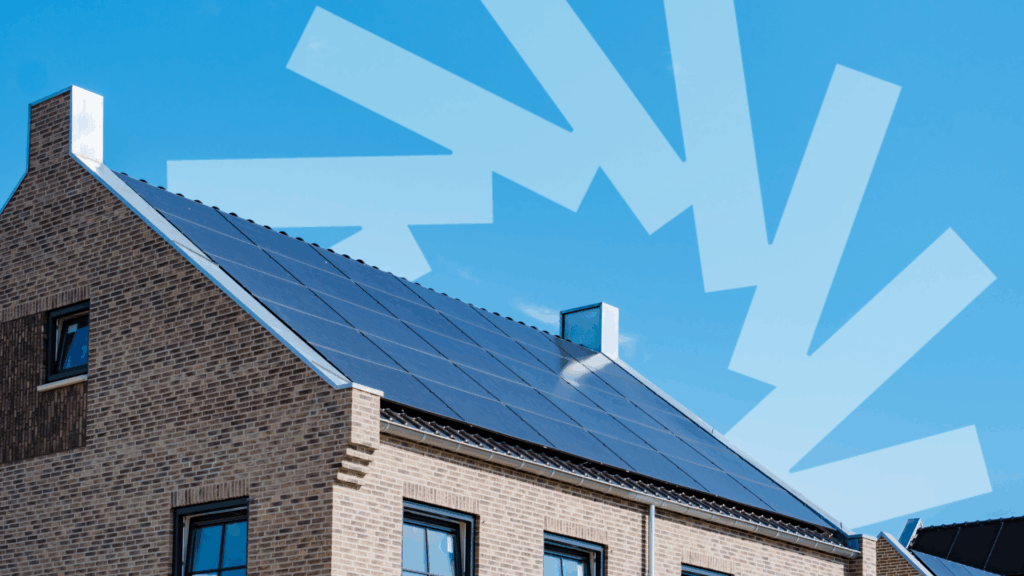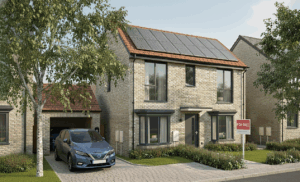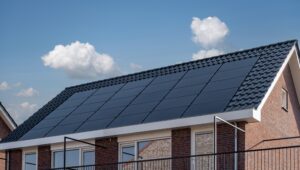UK homes are using more electricity than ever, and that trend is only accelerating. Even as our homes and appliances become more energy efficient, overall demand continues to climb: heating systems are switching to electric, EV ownership is rising, and households depend on more devices every day. In effect, our homes are becoming energy-hungry by design.
Yet most new homes are still being built to meet yesterday’s energy profile – not tomorrow’s. Small solar installations may tick the box for current regulations, but they deliver very little in terms of real savings for residents – and leave households vastly underprepared for a fully electrified future.
That’s why fitting new homes with full-sized solar and battery systems – designed to power real, long-term demand – is no longer a ‘nice to have’. It’s essential.
Home Energy Use Has Changed (And It’s Still Changing)
A generation ago, about 80% of a home’s energy was used for heating and hot water, mostly powered by gas. Electricity demand was low and predictable, covering lighting and a few appliances.
Today, the balance has shifted. Modern homes are packed with power-hungry appliances, entertainment systems, home offices, EVs and connected devices. While heating remains a major factor, much more of a household’s energy now goes toward what’s called unregulated demand, which means homes aren’t just consuming more energy – they’re using it differently, at different times, and often more intensively.
That pressure is only set to increase. Gas boilers are being replaced by electric heat pumps, and EVs are becoming the norm. A home with both can easily double or triple its peak electricity demand compared to a gas-heated home, often at the exact times the grid is most under strain.
This is why homes need to be designed for greater energy independence. Full-scale solar and storage aren’t just a sustainability upgrade – they’re essential to keep up with how homes will use energy in the years ahead.
Preparing for Mandatory Solar – And Why Not All Solar Is Equal
Solar will soon be mandatory for new-build homes under the imminent Future Homes Standard. But not all solar is equal. Small systems built for minimal compliance do little to offset real-world energy demand. They often generate power when households don’t need it and feed it back to the grid at low value, leaving homeowners to still pay peak prices in the evening.
Full-scale solar, properly sized to match future demand, can cover the majority of a home’s energy needs, reduce reliance on the grid and give residents greater protection from rising bills.
So, What Does ‘Full-Scale Solar’ Look Like In Practice?
As a guide, we’d expect a typical three-bedroom home to require around 12–16 solar panels (roughly 4–6kW) to make a meaningful difference to its energy use. A five-bedroom home could expect to need between 18–24 panels (7–9kW or more) depending on its size, orientation and usage profile. Many new-builds are still being fitted with just 2–4 panels – far short of what’s required to support future electrified energy demand.
But it’s not the size of a solar array alone that matters. Future-ready homes also need to be flexible, with onsite battery storage. Batteries have myriad benefits. They store excess solar energy when it’s abundant during the day and make it available in the evening, when usage spikes and grid electricity is at its most expensive. They help smooth out peaks and troughs in usage, reduce stress on the grid, and enable homes to respond to dynamic pricing or demand-side services. And while batteries also boost a home’s SAP score and EPC rating, there is currently no requirement under the Future Homes Standard for them to be included – meaning new builds risk missing out on a technology that delivers both immediate and long-term value.
As the UK energy system becomes more decentralised and connected, homes that can participate in this shift – rather than simply drawing power – will be better placed to benefit from new savings, services and incentives.
Removing the Cost Barrier
The challenge with full-scale solar has always been cost. Larger arrays and battery storage can add £10,000–£15,000 or more to build costs, which often gets passed on to buyers in the sale price.
Gryd solves this problem.
Our solar leasing model removes the hardware cost of solar entirely. We design, fund and maintain fully integrated rooftop solar and battery systems at zero capex for developers. Homeowners pay a fixed monthly subscription for 25 years, enjoy immediate energy savings, and never have to worry about ownership or maintenance of the solar system powering their home.
Want to learn more about Gryd’s solar leasing model? We’re working with developers across the UK to deliver energy systems built for what’s next. Contact us to bring Gryd to your next project – or ask your housebuilder about homes powered by Gryd.





